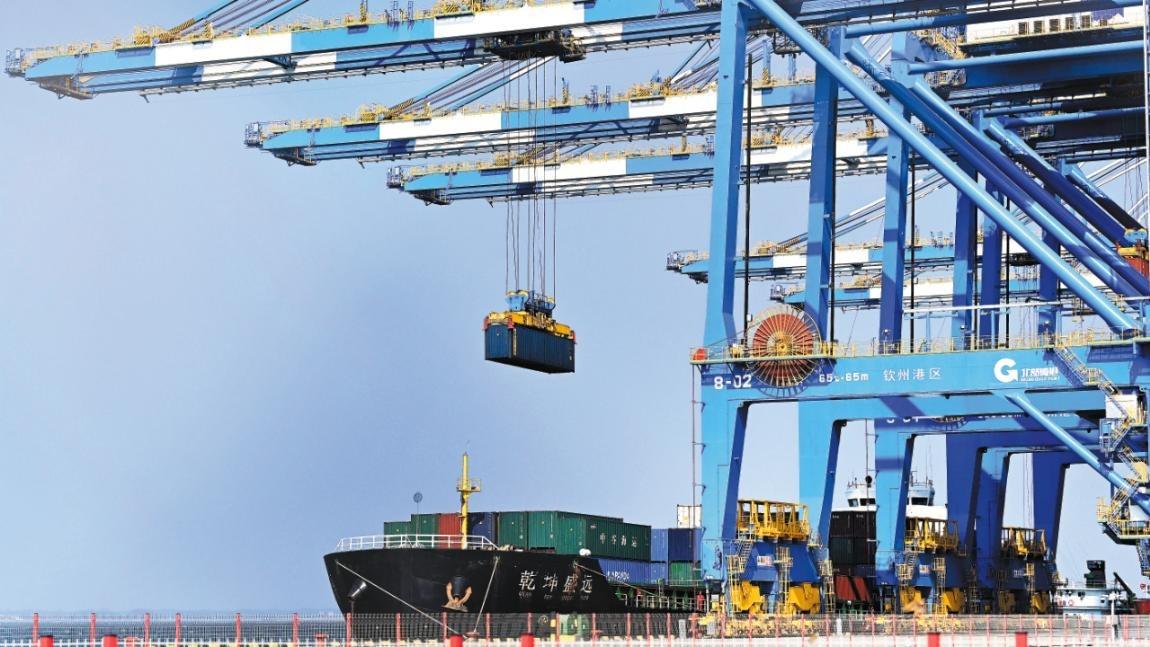Global freight route expected to propel opening-up of western, inland regions

President Xi Jinping has spelled out a new vision for the opening-up of China's western region, with the New International Land-Sea Trade Corridor expected to continue spearheading efforts to boost trade and logistics links between the region and global markets.
Xi made a visit to Chongqing in Southwest China from April 22 to 24, during which he listened to briefings on the development of the corridor, a landmark land-sea freight route between China's western region and countries of the Association of Southeast Asian Nations and beyond.
READ MORE: Xi stresses boosting development of China's western region
At a symposium with officials on Tuesday, Xi laid out an overarching vision to bolster the level of opening-up in the western region, calling for vigorous efforts to advance the development of the corridor.
He stressed the need to use the landmark trade and logistics initiative to propel the development and opening-up of participating regions, enabling their further involvement in the Belt and Road Initiative.
"We must ensure the successful construction and operation of this landmark project to drive high-level opening-up in the western and inland regions, and create a hub of interconnected networks," Xi told officials during the trip.
Officials and analysts have underlined the strong emphasis from Xi on development of the corridor in bolstering the opening-up of the western region, which covers more than 70 percent of China's land area and is home to nearly a third of the country's population.
According to the National Development and Reform Commission, the corridor, located in the hinterlands of the western region, now mainly comprises three trade and logistics channels, connecting Chongqing and Chengdu, Sichuan province, with ports on the Beibu Gulf in the South China Sea.
Xie Bin, head of Chongqing Customs, said the president showed a particular concern for the development and opening-up of the western region during the fact-finding trip and the symposium.
"Xi's remarks during the trip underscored that he places high hopes on the corridor as a strategic channel for the development of the western region," Xie said.
He added that the western region is now facing significant opportunities to advance to higher levels of opening-up, with the corridor expected to serve as a springboard for the region to improve its foreign trade structure.
According to official statistics, the corridor has extended beyond ASEAN and now reaches 121 countries and regions as well as 503 ports. The trade channel saw its cargo volume rise 21 percent year-on-year in 2023, with 8.82 billion yuan ($1.22 billion) worth of electric vehicles, lithium-ion batteries and photovoltaic products exported via the trade route.
Businesses that import chromium and lithium ore to southwestern China via the corridor can save 15 to 20 days in transportation time and 1,700 yuan per twenty-foot equivalent unit in logistics costs, Xie said.
Chongqing Customs has rolled out tailored policies for rail-sea cargo transported via the corridor, which has reduced the tax burden on freight costs by 60 percent, he added.
"Facilitated by the corridor, watermelons from Vietnam, wild aquatic products from Indonesia, and cashew nuts and mangoes from Laos have made their way to the dining tables of Chinese families," Xie said.
Lei Xiaohua, a research fellow on Southeast Asia at the Guangxi Academy of Social Sciences, said one of the key messages from the president during his trip to Chongqing was that the New International Land-Sea Trade Corridor is a major part of the national strategy for integrated regional development.
"It demonstrated the nation's resolve to accelerate the opening-up of the western region, including attracting more domestic and foreign investment through better infrastructure and promoting deep-seated economic reforms and opening-up," Lei said.
The corridor will enable the western region to significantly boost its level of attractiveness to foreign investment with better infrastructure and greater transportation efficiency, he added.
"It will lure more foreign businesses to invest in the western region and expedite its growth and opening-up," he said.
With stronger economic integration between China and ASEAN, the strategic value of the corridor will be even more prominent, while the corridor will also serve as a pillar for the China-ASEAN Free Trade Area, he said.
ASEAN has been China's largest trading partner since 2020, while China has been the regional organization's largest trading partner since 2009, according to the General Administration of Customs. Trade between China and ASEAN reached 6.41 trillion yuan last year, or 15.35 percent of China's total foreign trade volume.
For businesses in Chongqing, the corridor has served as a gateway for their expansion into global markets.
Dai Xiaoqiang, general manager of Chongqing Huida Lemon Technology Group, said the corridor has made it much easier for the company to export fresh lemons to ASEAN markets, including Thailand and Singapore.
"Efficient and smooth logistics was instrumental in our branding efforts in different markets," Dai said.
ALSO READ: China says ready to work with Cambodia to promote community with shared future
Chongqing exported over 100,000 metric tons of fresh lemons, worth 1 billion yuan, last year to over 30 countries and regions in Europe, the Middle East and Southeast Asia, thanks to the corridor and the China-Europe Railway Express.
Yi Wen, vice-president of Chongqing Meixin Group, a door manufacturer, said the corridor has facilitated the exporting of its products to over 40 countries and regions, cutting the cost of logistics by more than 15 percent.
"We believe the corridor will continue to enhance logistics efficiency and reduce costs for enterprises," Yi said. "It will also expand the business networks for us, making it possible to participate in more construction projects across different countries and secure more export orders."
Deng Rui in Chongqing contributed to this story.
Contact the writers at xuwei@chinadaily.com.cn


